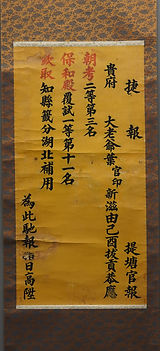
單元二:讀書真種子
Section 2: The True Seed of Intellectual Development
淡水廳初設時,人才尚少。殆至乾隆年間建立明志書院,學子有機會親炙碩儒。讀四書、誦五經,從此文風漸盛。士子咸思有朝一日能夠榮登科甲,無不日課時文,青燈黃卷,準備在科考中大展身手。道光三年,鄭用錫會試中式,為臺灣入清治理以來首位進士,竹塹人文光照全臺。鄭用錫致仕返鄉後,又講學於明志書院,培育下一代士子。本單元展示鄭氏、書院與科舉文物,「讀書真種子」於此滋養傳承。
There were few scholars in the early days when Tanshi Ting (淡水廳) was first established. It was not until the latter half of the 18th century when Ming-Chih College (明志書院) was founded that students had the opportunity to meet with learned teachers and study the Four Books and The Five Classics. The cultural milieu began to thrive in the city. Many students took classes during the day and practiced writing throughout the night, all hoping to attain the honor of passing the imperial examination. In the third year of the Daoguang reign (1823), Zheng Yongxi became the first Jinshi (進士) from Taiwan since the Qing administration governed the island. His feat sent waves of joy across Taiwan, immediately catapulting Tek-chhàm as the city of scholarly achievements. Later on Zheng taught at Ming-Chih College to inculcate the next generation of scholars after resigning from his official post and returning to his hometown. From Zheng Yongxi, Ming-Chih College to the imperial examination, this section consists of related artifacts to show the burgeoning of the true seed of intellectual development in Hsinchu.
.jpg)






